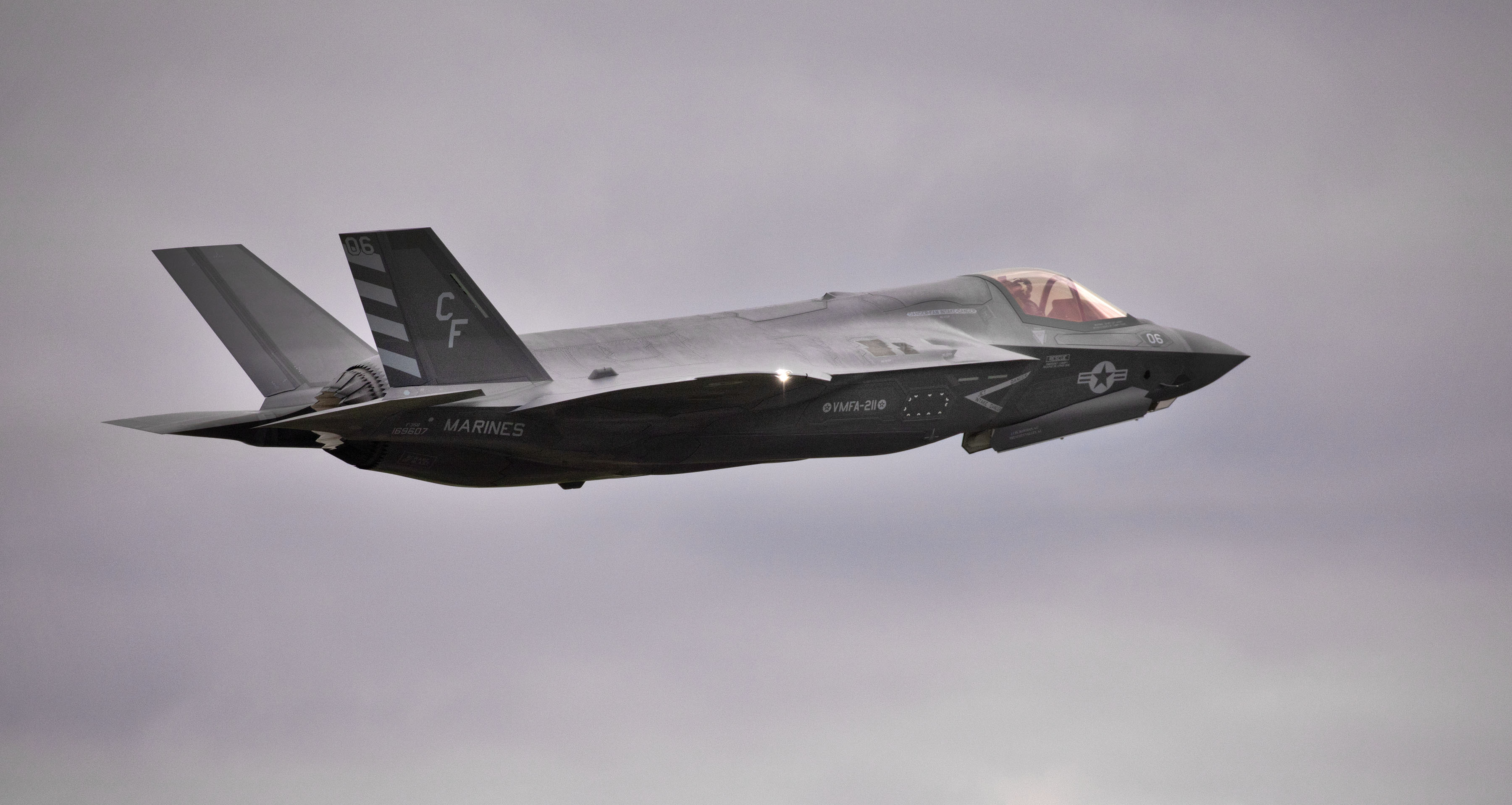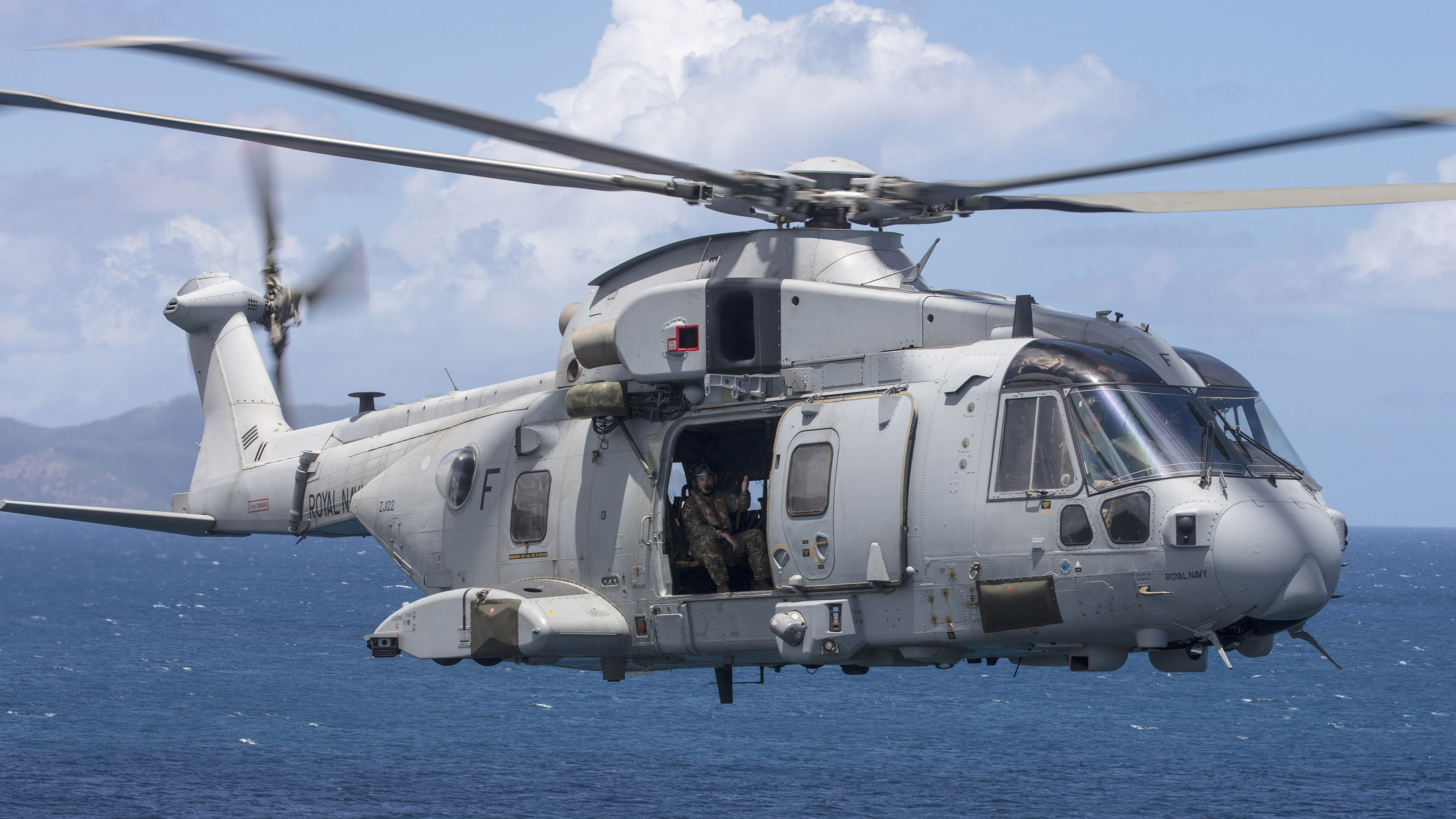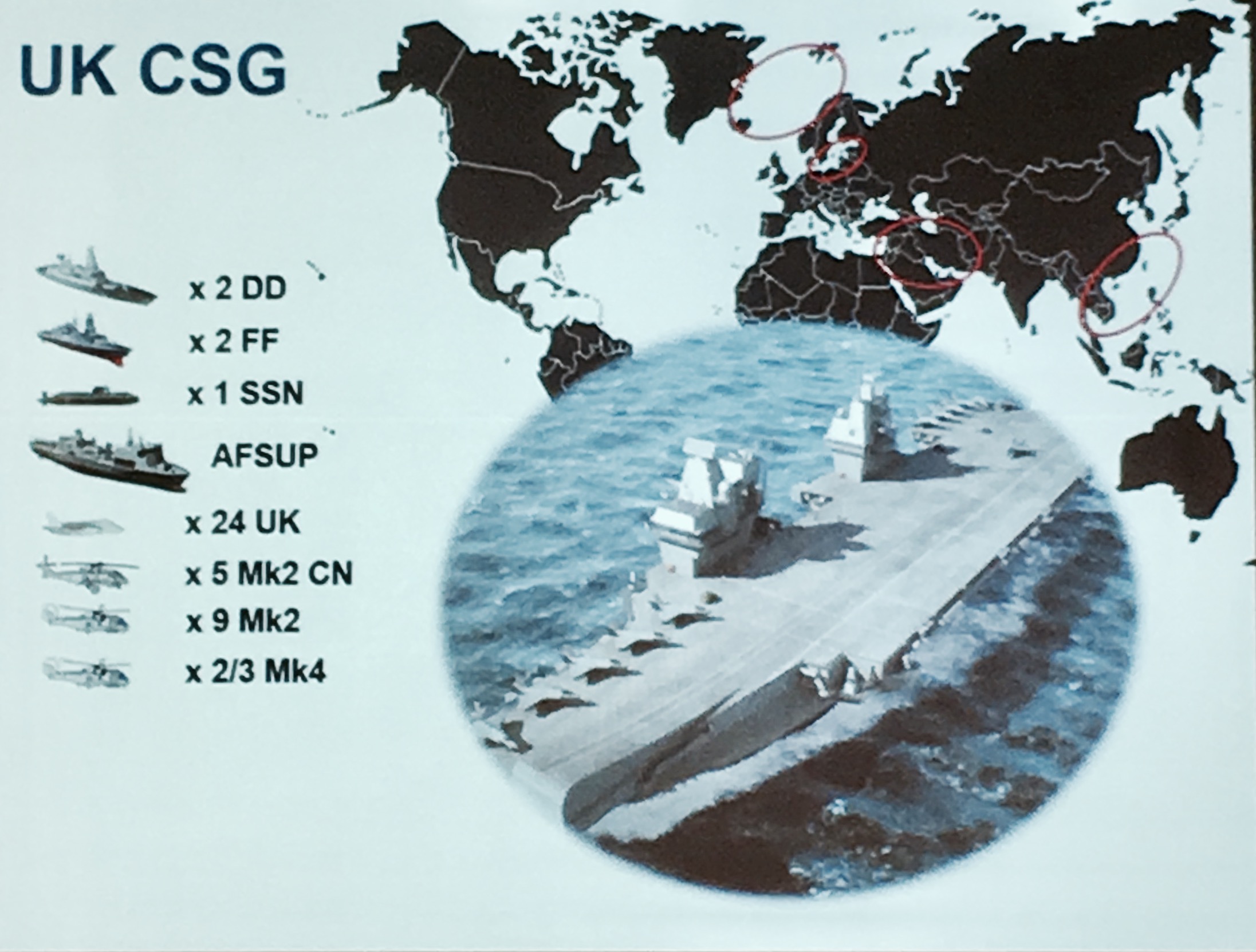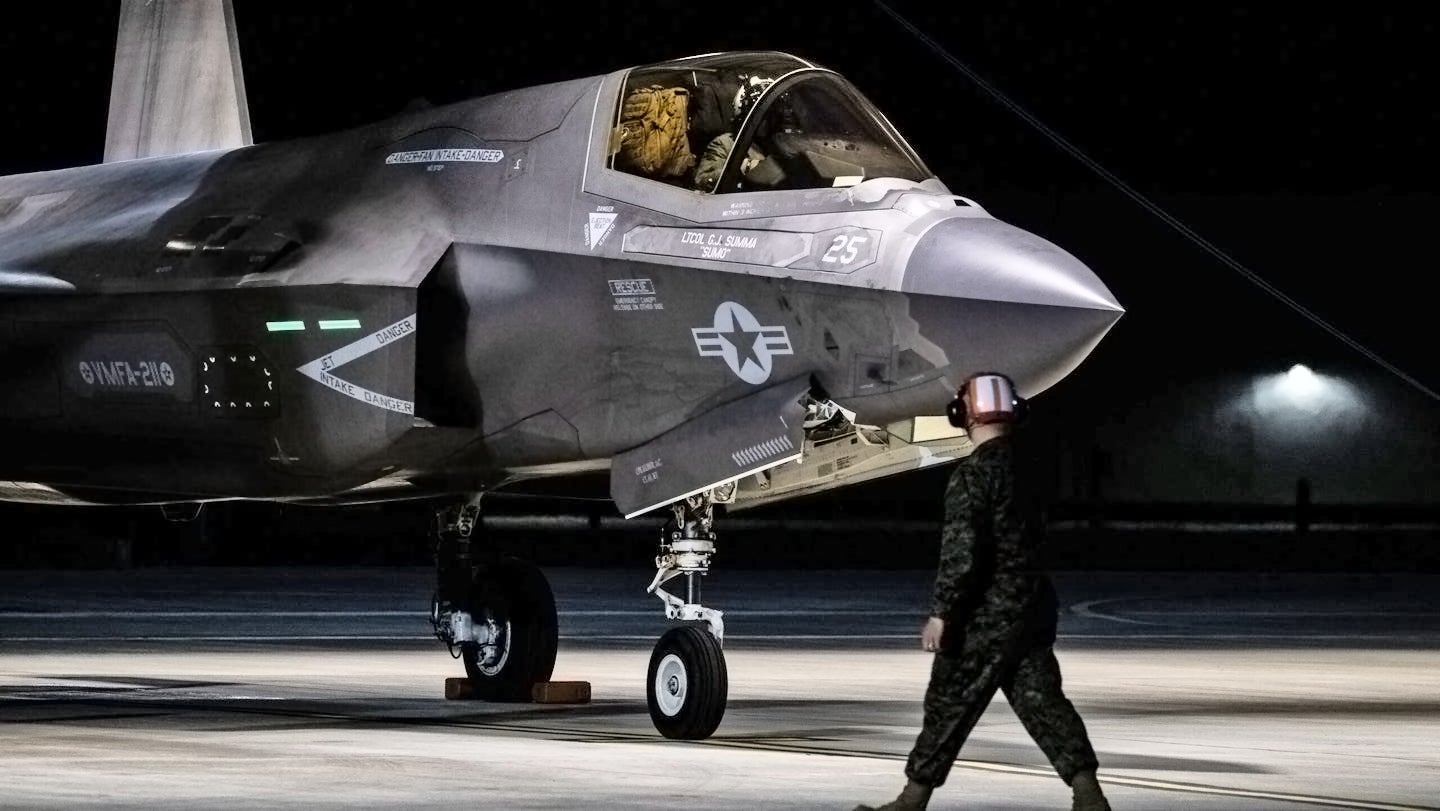Ten U.S. Marine Corps F-35Bs that touched down in the United Kingdom recently are preparing to embark aboard the Royal Navy’s aircraft carrier HMS Queen Elizabeth. It’s set to be the start of an enduring relationship between the warship and F-35B units of both countries.
The short take-off and vertical landing (STOVL) F-35Bs from Marine Fighter Attack Squadron (VMFA) 211, the “Wake Island Avengers,” touched down at RAF Marham, Norfolk, in the east of England, in two waves, on September 3, 2020, having flown from Marine Corps Air Station Beaufort, South Carolina. While U.S. Marine Corps F-35Bs have visited the United Kingdom before, this is the first time for VMFA-211, and Marine F-35Bs have never before made such an extensive deployment to the country.
Spinning-up
After a period of work-ups, and assorted exercises flown from their temporary land base at RAF Marham, home of the United Kingdom’s Lightning Force, the “Wake Island Avengers” will put their jets aboard HMS Queen Elizabeth. The Royal Navy’s flagship is going to sea with British and American jets on board as it spins up for its first operational deployment, which will be to the Pacific region next year under the banner of Carrier Strike Group 21, or CSG21. This, too, will involve significant VMFA-211 participation.
Currently, the 10 U.S. Marine Corps F-35Bs are working alongside their counterparts from the Royal Air Force’s No 617 Squadron, the “Dambusters” — the first of the frontline U.K. Lightning units. Since so much of the training involved in the Joint Strike Fighter enterprise is synthetic, the U.S. pilots initially worked in Marham’s simulators, becoming familiarized with the local airspace and procedures.
As the United Kingdom builds up toward the carrier strike role, and a debut operational cruise for HMS Queen Elizabeth, September 10 saw VMFA-211 and No 617 Squadron take part in Exercise Point Blank 20-4. This didn’t include the carrier, but pitted the F-35Bs against RAF Typhoon fighter jets that worked as Red Air adversaries. Other assets involved came from the U.S. Air Force’s 48th Fighter Wing at nearby RAF Lakenheath, Suffolk, as well as the Royal Netherlands Air Force.

Later this month, the “Wake Island Avengers” and “Dambusters” will go aboard HMS Queen Elizabeth and then undertake carrier qualification training to ensure all pilots are able to operate from the vessel during both day and night.
The two F-35B squadrons will then team up with two embarked Merlin helicopter squadrons to take part in Exercise Joint Warrior, due to begin on September 21. Training will include the delivery of live and inert weapons. Joint Warrior is a biannual set of maneuvers that takes place in and around Scotland and Northern England. It is described by the U.K. Ministry of Defence as the “largest military exercise in Europe.” It typically brings together participants from the Royal Navy, Royal Air Force, and the British Army, as well as foreign forces.
The at-sea phase won’t be the end of VMFA-211’s sojourn in the United Kingdom. Once Joint Warrior is over, the two F-35B squadrons will return to RAF Marham to take part in Exercise Crimson Warrior. According to the U.K. Ministry of Defence, this will comprise “high-end training, alongside other platforms, in a contested environment with this year’s focus being on Multi-Domain Operations.”

While a precise definition of Multi-Domain Operations has yet to be provided, it generally implies a level of tactical integration beyond conventional “Joint” operations. This suggests that Crimson Warrior will see F-35Bs acting very closely alongside other air, land, and sea assets, likely making use of their much-vaunted data-sharing capability.
Back to the boat
Meanwhile, on the south coast of England, HMS Queen Elizabeth sailed from HM Naval Base Portsmouth on September 9, after a delay due to an outbreak of COVID-19 among the ship’s crew. The warship will conduct trials before returning to Portsmouth and taking on the stores required before embarking more aircraft — including the F-35Bs.
The 2010 Strategic Defence and Security Review (SDSR) had left the Royal Navy without any fixed-wing aircraft carrier. As a cost-cutting measure, the U.K. Ministry of Defence axed the navy’s last strike carrier, HMS Ark Royal, from the Invincible class, together with the warship’s complement of Harrier GR9 strike fighters. On November 24 that year, the last four Harriers left the deck of Ark Royal and returned to their land base at RAF Cottesmore, Lincolnshire, where the jets were decommissioned.

With the United Kingdom now back in the fixed-wing carrier business, officials have described a 24-aircraft Lightning air group as a “credible compliment” for the Carrier Strike role. Although the Queen Elizabeth-class carriers are designed to operate a maximum of 36 F-35Bs (equivalent to three squadrons), this is not expected to be a regular occurrence, though.
HMS Queen Elizabeth left port with at least six Merlin HM2 anti-submarine helicopters arranged on deck, but this is just the beginning of what the Royal Navy has promised will be its biggest carrier aviation embarkation “since HMS Hermes.” This earlier-generation carrier was retired by the United Kingdom in 1984 but had previously served in the Falklands conflict with an air group of 16 Sea Harriers, 10 RAF Harrier GR3s, and 10 Sea King helicopters. It should be remembered that HMS Hermes, and the subsequent STOVL carriers of the Invincible class, were much smaller ships than the Queen Elizabeth-class, with considerably less space for embarked aviation.
The Merlin HC4 is also planned to go aboard HMS Queen Elizabeth for the next at-sea phase, but the delayed Merlin Crowsnest variant, outfitted with a roll-on/roll-off airborne early warning and control (AEW&C) suite, is not yet ready to go to sea.

Crowsnest is considered a vital capability for the Carrier Strike Group, which will normally also include at least one destroyer, an anti-submarine warfare frigate, plus ships for support and resupply. A nuclear fast attack submarine will also likely join the flotilla. There have been continuous concerns over the Royal Navy’s ability to provide these additional vessels for carrier strike group cruises, especially with two carriers to support. Regardless, without Crowsnest, the group’s ability to conduct long-range air, sea, and land surveillance — including detecting, tracking, and identify threats beyond the horizon — is notably diminished. The Royal Navy does expect to have five Crowsnest helicopters available to deploy for CSG21, although full operational capability will have to wait until May 2023.
Exactly what the first iteration of the Anglo-American carrier air group will look like is unclear, but we do know that it should contain more aircraft than were aboard the Invincible-class carrier HMS Ark Royal in 1987, for example. This comprised of 12 Sea Harriers, six RAF Harrier GR3s, and four Sea King helicopters, for a total of 22 aircraft.
In September 2001, another large-scale embark involved the Invincible-class carrier HMS Illustrious going to sea with eight Sea Harriers, eight RAF Harrier GR7s, and five Sea King helicopters, for a total of 21. The Royal Navy has confirmed the 2020 cruise will involve “near enough double” the number of aircraft, though this presumably refers to only the fixed-wing types in the September 2001 cruise — 16 in all.
The plan versus reality
So, how realistic is this plan? The United Kingdom currently has 15 F-35Bs at RAF Marham. Another three are at Edwards Air Force Base in California for ongoing test and evaluation work, and three more are planned for delivery this year, although the timeline may be delayed by the coronavirus pandemic.
Add to this the 10 jets from the “Wake Island Avengers” now in England, and, on paper, it’s possible that the Royal Navy plans to put as many as 25 Lightnings on the warship later this month. This number would roughly tally with aspirations outlined in the past involving a future Carrier Strike Group comprising 24 F-35Bs, 14 Merlin HM2s, and two or three Merlin HC4s that operate in the amphibious assault/logistic support role.

While there are 15 British-owned F-35Bs at RAF Marham now, it must be remembered that these are shared between the initial frontline unit, No 617 Squadron, and the operational conversion unit, No 207 Squadron, which is tasked with training the personnel to operate the jets as the force expands. In addition, not all of the aircraft are likely to be in a state in which they are ready for shipboard deployment. The F-35 is significantly maintenance-intensive and there are parts shortages and other hurdles that are still being felt across the entire F-35 enterprise in the form of depressed readiness rates. As such, it is more likely that significantly fewer than the 15 airframes at Marham will be sent alongside their USMC cousins to the ship for the high-profile deployment.
That the U.S. Marine Corps F-35Bs may outnumber their RAF brethren on the deck of the Royal Navy’s flagship has been the cause of some consternation within sections of the British media, but this air group has been planned for some time.

An initiative to deploy U.S. Marine Corps F-35Bs on the British carrier was announced back in September 2016 and formalized the following December with an agreement signed between the then U.K. Defence Secretary Michael Fallon and his U.S. counterpart, Ash Carter.
Indeed, in September 2016, Commodore Jerry Kyd, the then-commander of HMS Queen Elizabeth, announced his aspiration to embark both U.S. Marine Corps F-35Bs and MV-22 Osprey tiltrotors on the carrier for a period of up to nine months. There’s no confirmation yet as to whether MV-22s will also take part in CSG21, but it’s clear that the U.K. military is keeping an eye on the tiltrotor program, which could provide a useful carrier on-board delivery capability and possibly other roles, as well, like an aerial refueling tanker asset.

Embarking American aircraft on the British carrier has therefore long been the objective, filling in the numbers as the United Kingdom works incrementally toward a planned fleet of 24 carrier-available jets by 2023 — as laid out in the government’s last SDSR in 2015. Currently, 48 F-35B jets are under contract. This would theoretically provide for a 24-aircraft Carrier Strike complement on each of the two Queen Elizabeth-carriers simultaneously, but, even if achievable, such a deployment seems extremely unlikely.
As well as boosting aircraft numbers, VMFA-211 will be able to share plenty of F-35B experience with the U.K. Lightning Force. The “Wake Island Avengers” was the first operational U.S. Marine Corps F-35B unit to go to war, deploying aboard the Wasp-class amphibious assault ship USS Essex in mid-2018 and flying combat missions in Afghanistan, Iraq, and Syria.

Long-term, the number of U.S. Marine Corps F-35Bs jets likely to be operating aboard Royal Navy carriers will depend heavily on the fate of U.K. orders beyond the 48 now jets committed to. Reports in the British media suggest that the original plan to acquire 138 F-35Bs across the life of the program could be cut by as many as half, which could mean U.S. Marine Corps jets remain regular tenants aboard British carriers.
Even if the United Kingdom presses ahead with a 138-aircraft Lightning fleet, there’s every chance that U.S. Marine Corps F-35Bs — and potentially other types too — will continue to undertake “cross-deck” operations with their British counterparts. The United Kingdom and the United States have a uniquely close military relationship, and with the U.S. Marine Corps and RAF/Royal Navy operating the same aircraft type, there is plenty of scope for integrated operations. The U.S. Navy is now down one of its big deck amphibious assault ships after USS Bonhomme Richard suffered extreme damage due to fire. This could make Marine deployments aboard the Royal Navy’s new carriers that much more enticing, at least for the foreseeable future.
In the meantime, if all goes according to plan, the U.K. Ministry of Defence will declare initial Carrier Strike capability in December 2020, and the personnel and aircraft of VMFA-211 will play an important part in attaining that milestone.
Contact the author: thomas@thedrive.com
